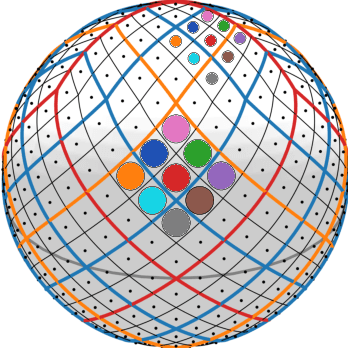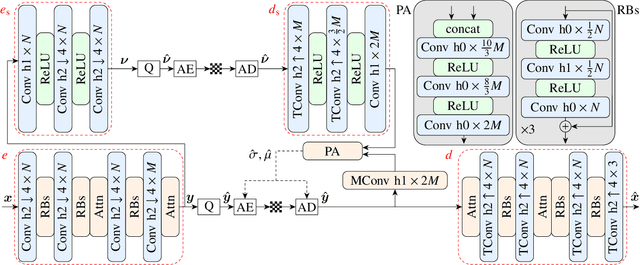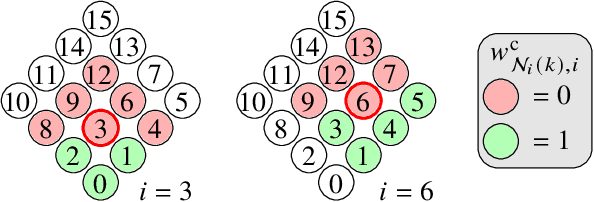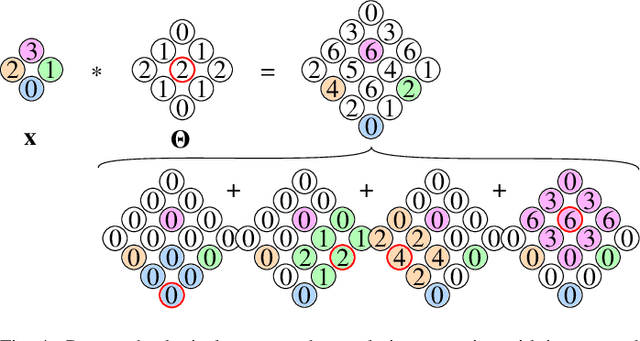Pascal Frossard
rETF-semiSL: Semi-Supervised Learning for Neural Collapse in Temporal Data
Aug 13, 2025Abstract:Deep neural networks for time series must capture complex temporal patterns, to effectively represent dynamic data. Self- and semi-supervised learning methods show promising results in pre-training large models, which -- when finetuned for classification -- often outperform their counterparts trained from scratch. Still, the choice of pretext training tasks is often heuristic and their transferability to downstream classification is not granted, thus we propose a novel semi-supervised pre-training strategy to enforce latent representations that satisfy the Neural Collapse phenomenon observed in optimally trained neural classifiers. We use a rotational equiangular tight frame-classifier and pseudo-labeling to pre-train deep encoders with few labeled samples. Furthermore, to effectively capture temporal dynamics while enforcing embedding separability, we integrate generative pretext tasks with our method, and we define a novel sequential augmentation strategy. We show that our method significantly outperforms previous pretext tasks when applied to LSTMs, transformers, and state-space models on three multivariate time series classification datasets. These results highlight the benefit of aligning pre-training objectives with theoretically grounded embedding geometry.
CM-UNet: A Self-Supervised Learning-Based Model for Coronary Artery Segmentation in X-Ray Angiography
Jul 22, 2025Abstract:Accurate segmentation of coronary arteries remains a significant challenge in clinical practice, hindering the ability to effectively diagnose and manage coronary artery disease. The lack of large, annotated datasets for model training exacerbates this issue, limiting the development of automated tools that could assist radiologists. To address this, we introduce CM-UNet, which leverages self-supervised pre-training on unannotated datasets and transfer learning on limited annotated data, enabling accurate disease detection while minimizing the need for extensive manual annotations. Fine-tuning CM-UNet with only 18 annotated images instead of 500 resulted in a 15.2% decrease in Dice score, compared to a 46.5% drop in baseline models without pre-training. This demonstrates that self-supervised learning can enhance segmentation performance and reduce dependence on large datasets. This is one of the first studies to highlight the importance of self-supervised learning in improving coronary artery segmentation from X-ray angiography, with potential implications for advancing diagnostic accuracy in clinical practice. By enhancing segmentation accuracy in X-ray angiography images, the proposed approach aims to improve clinical workflows, reduce radiologists' workload, and accelerate disease detection, ultimately contributing to better patient outcomes. The source code is publicly available at https://github.com/CamilleChallier/Contrastive-Masked-UNet.
MEMOIR: Lifelong Model Editing with Minimal Overwrite and Informed Retention for LLMs
Jun 09, 2025Abstract:Language models deployed in real-world systems often require post-hoc updates to incorporate new or corrected knowledge. However, editing such models efficiently and reliably - without retraining or forgetting previous information - remains a major challenge. Existing methods for lifelong model editing either compromise generalization, interfere with past edits, or fail to scale to long editing sequences. We propose MEMOIR, a novel scalable framework that injects knowledge through a residual memory, i.e., a dedicated parameter module, while preserving the core capabilities of the pre-trained model. By sparsifying input activations through sample-dependent masks, MEMOIR confines each edit to a distinct subset of the memory parameters, minimizing interference among edits. At inference, it identifies relevant edits by comparing the sparse activation patterns of new queries to those stored during editing. This enables generalization to rephrased queries by activating only the relevant knowledge while suppressing unnecessary memory activation for unrelated prompts. Experiments on question answering, hallucination correction, and out-of-distribution generalization benchmarks across LLaMA-3 and Mistral demonstrate that MEMOIR achieves state-of-the-art performance across reliability, generalization, and locality metrics, scaling to thousands of sequential edits with minimal forgetting.
Single-Input Multi-Output Model Merging: Leveraging Foundation Models for Dense Multi-Task Learning
Apr 15, 2025Abstract:Model merging is a flexible and computationally tractable approach to merge single-task checkpoints into a multi-task model. Prior work has solely focused on constrained multi-task settings where there is a one-to-one mapping between a sample and a task, overlooking the paradigm where multiple tasks may operate on the same sample, e.g., scene understanding. In this paper, we focus on the multi-task setting with single-input-multiple-outputs (SIMO) and show that it qualitatively differs from the single-input-single-output model merging settings studied in the literature due to the existence of task-specific decoders and diverse loss objectives. We identify that existing model merging methods lead to significant performance degradation, primarily due to representation misalignment between the merged encoder and task-specific decoders. We propose two simple and efficient fixes for the SIMO setting to re-align the feature representation after merging. Compared to joint fine-tuning, our approach is computationally effective and flexible, and sheds light into identifying task relationships in an offline manner. Experiments on NYUv2, Cityscapes, and a subset of the Taskonomy dataset demonstrate: (1) task arithmetic suffices to enable multi-task capabilities; however, the representations generated by the merged encoder has to be re-aligned with the task-specific heads; (2) the proposed architecture rivals traditional multi-task learning in performance but requires fewer samples and training steps by leveraging the existence of task-specific models.
Revisiting Automatic Data Curation for Vision Foundation Models in Digital Pathology
Mar 24, 2025Abstract:Vision foundation models (FMs) are accelerating the development of digital pathology algorithms and transforming biomedical research. These models learn, in a self-supervised manner, to represent histological features in highly heterogeneous tiles extracted from whole-slide images (WSIs) of real-world patient samples. The performance of these FMs is significantly influenced by the size, diversity, and balance of the pre-training data. However, data selection has been primarily guided by expert knowledge at the WSI level, focusing on factors such as disease classification and tissue types, while largely overlooking the granular details available at the tile level. In this paper, we investigate the potential of unsupervised automatic data curation at the tile-level, taking into account 350 million tiles. Specifically, we apply hierarchical clustering trees to pre-extracted tile embeddings, allowing us to sample balanced datasets uniformly across the embedding space of the pretrained FM. We further identify these datasets are subject to a trade-off between size and balance, potentially compromising the quality of representations learned by FMs, and propose tailored batch sampling strategies to mitigate this effect. We demonstrate the effectiveness of our method through improved performance on a diverse range of clinically relevant downstream tasks.
OSLO-IC: On-the-Sphere Learned Omnidirectional Image Compression with Attention Modules and Spatial Context
Mar 17, 2025



Abstract:Developing effective 360-degree (spherical) image compression techniques is crucial for technologies like virtual reality and automated driving. This paper advances the state-of-the-art in on-the-sphere learning (OSLO) for omnidirectional image compression framework by proposing spherical attention modules, residual blocks, and a spatial autoregressive context model. These improvements achieve a 23.1% bit rate reduction in terms of WS-PSNR BD rate. Additionally, we introduce a spherical transposed convolution operator for upsampling, which reduces trainable parameters by a factor of four compared to the pixel shuffling used in the OSLO framework, while maintaining similar compression performance. Therefore, in total, our proposed method offers significant rate savings with a smaller architecture and can be applied to any spherical convolutional application.
How compositional generalization and creativity improve as diffusion models are trained
Feb 17, 2025



Abstract:Natural data is often organized as a hierarchical composition of features. How many samples do generative models need to learn the composition rules, so as to produce a combinatorial number of novel data? What signal in the data is exploited to learn? We investigate these questions both theoretically and empirically. Theoretically, we consider diffusion models trained on simple probabilistic context-free grammars - tree-like graphical models used to represent the structure of data such as language and images. We demonstrate that diffusion models learn compositional rules with the sample complexity required for clustering features with statistically similar context, a process similar to the word2vec algorithm. However, this clustering emerges hierarchically: higher-level, more abstract features associated with longer contexts require more data to be identified. This mechanism leads to a sample complexity that scales polynomially with the said context size. As a result, diffusion models trained on intermediate dataset size generate data coherent up to a certain scale, but that lacks global coherence. We test these predictions in different domains, and find remarkable agreement: both generated texts and images achieve progressively larger coherence lengths as the training time or dataset size grows. We discuss connections between the hierarchical clustering mechanism we introduce here and the renormalization group in physics.
NMT-Obfuscator Attack: Ignore a sentence in translation with only one word
Nov 19, 2024



Abstract:Neural Machine Translation systems are used in diverse applications due to their impressive performance. However, recent studies have shown that these systems are vulnerable to carefully crafted small perturbations to their inputs, known as adversarial attacks. In this paper, we propose a new type of adversarial attack against NMT models. In this attack, we find a word to be added between two sentences such that the second sentence is ignored and not translated by the NMT model. The word added between the two sentences is such that the whole adversarial text is natural in the source language. This type of attack can be harmful in practical scenarios since the attacker can hide malicious information in the automatic translation made by the target NMT model. Our experiments show that different NMT models and translation tasks are vulnerable to this type of attack. Our attack can successfully force the NMT models to ignore the second part of the input in the translation for more than 50% of all cases while being able to maintain low perplexity for the whole input.
Graph-Dictionary Signal Model for Sparse Representations of Multivariate Data
Nov 08, 2024Abstract:Representing and exploiting multivariate signals require capturing complex relations between variables. We define a novel Graph-Dictionary signal model, where a finite set of graphs characterizes relationships in data distribution through a weighted sum of their Laplacians. We propose a framework to infer the graph dictionary representation from observed data, along with a bilinear generalization of the primal-dual splitting algorithm to solve the learning problem. Our new formulation allows to include a priori knowledge on signal properties, as well as on underlying graphs and their coefficients. We show the capability of our method to reconstruct graphs from signals in multiple synthetic settings, where our model outperforms previous baselines. Then, we exploit graph-dictionary representations in a motor imagery decoding task on brain activity data, where we classify imagined motion better than standard methods relying on many more features.
LiNeS: Post-training Layer Scaling Prevents Forgetting and Enhances Model Merging
Oct 22, 2024Abstract:Large pre-trained models exhibit impressive zero-shot performance across diverse tasks, but fine-tuning often leads to catastrophic forgetting, where improvements on a target domain degrade generalization on other tasks. To address this challenge, we introduce LiNeS, Layer-increasing Network Scaling, a post-training editing technique designed to preserve pre-trained generalization while enhancing fine-tuned task performance. LiNeS scales parameter updates linearly based on their layer depth within the network, maintaining shallow layers close to their pre-trained values to preserve general features while allowing deeper layers to retain task-specific representations. We further extend this approach to multi-task model merging scenarios, where layer-wise scaling of merged parameters reduces negative task interference. LiNeS demonstrates significant improvements in both single-task and multi-task settings across various benchmarks in vision and natural language processing. It mitigates forgetting, enhances out-of-distribution generalization, integrates seamlessly with existing multi-task model merging baselines improving their performance across benchmarks and model sizes, and can boost generalization when merging LLM policies aligned with different rewards via RLHF. Importantly, our method is simple to implement and complementary to many existing techniques.
 Add to Chrome
Add to Chrome Add to Firefox
Add to Firefox Add to Edge
Add to Edge